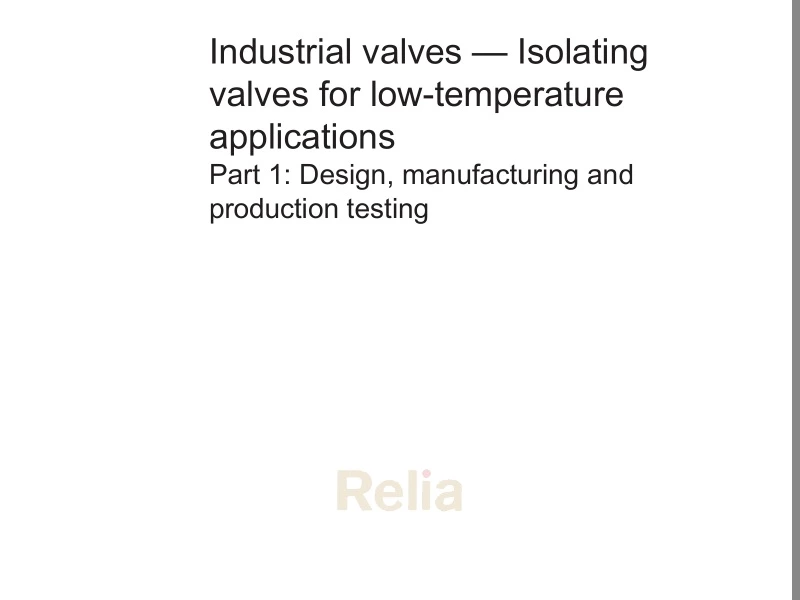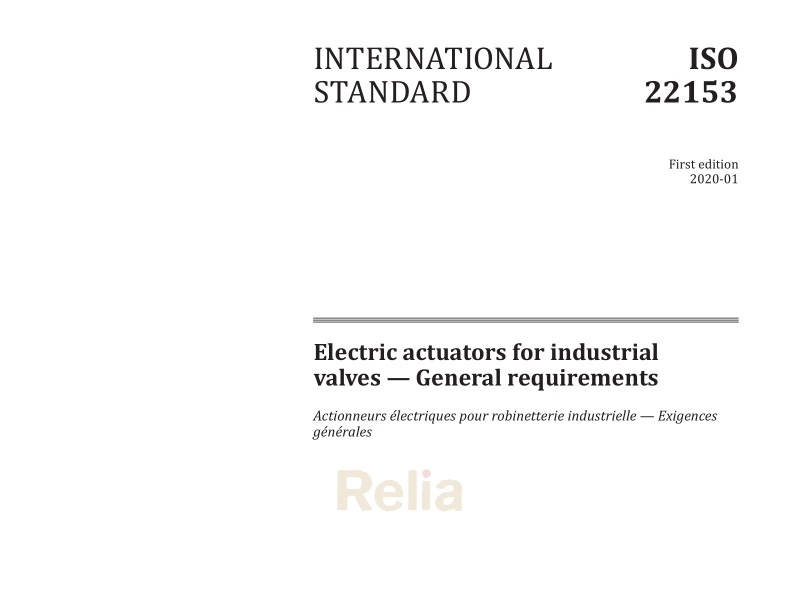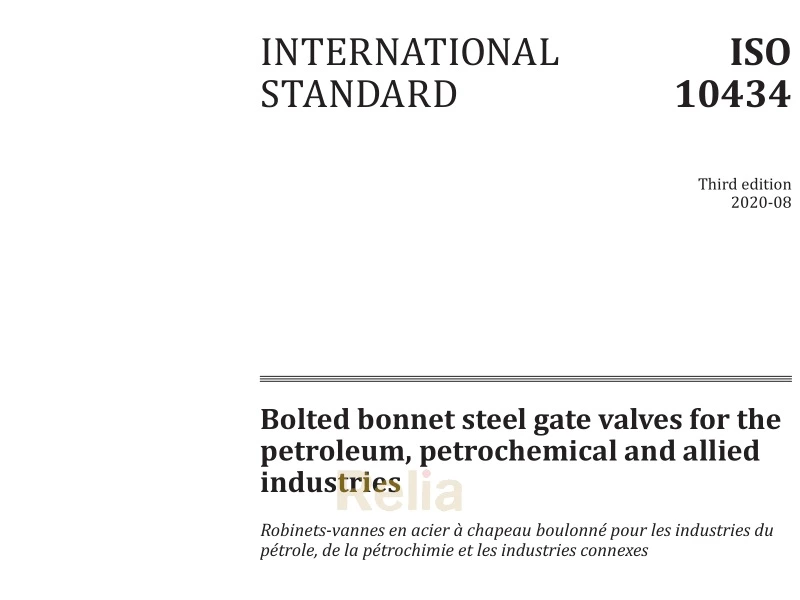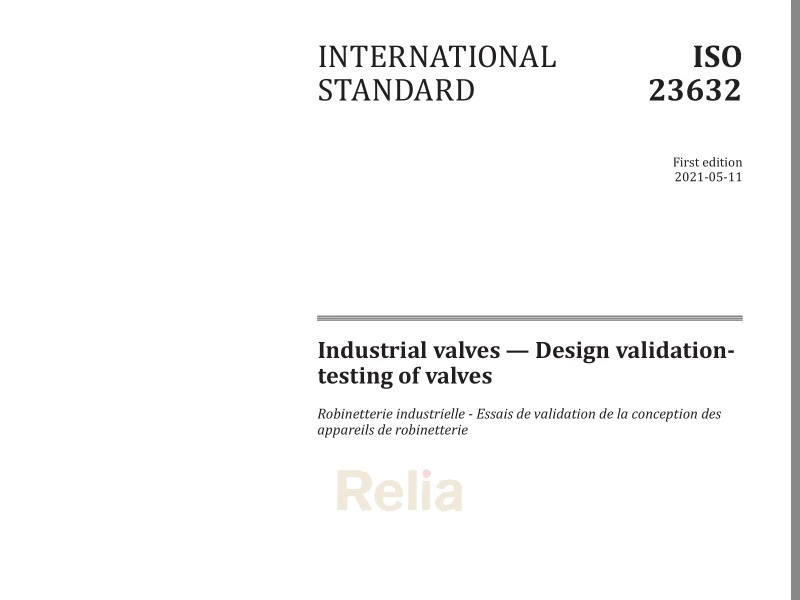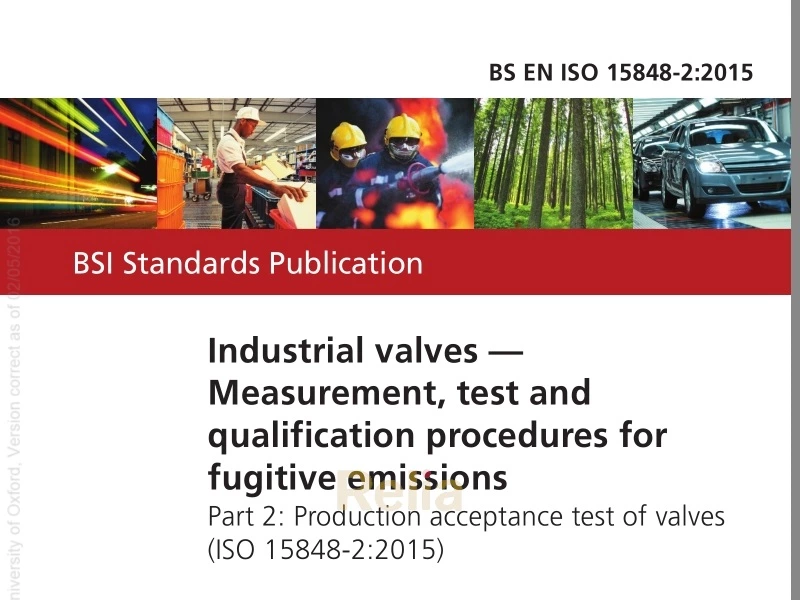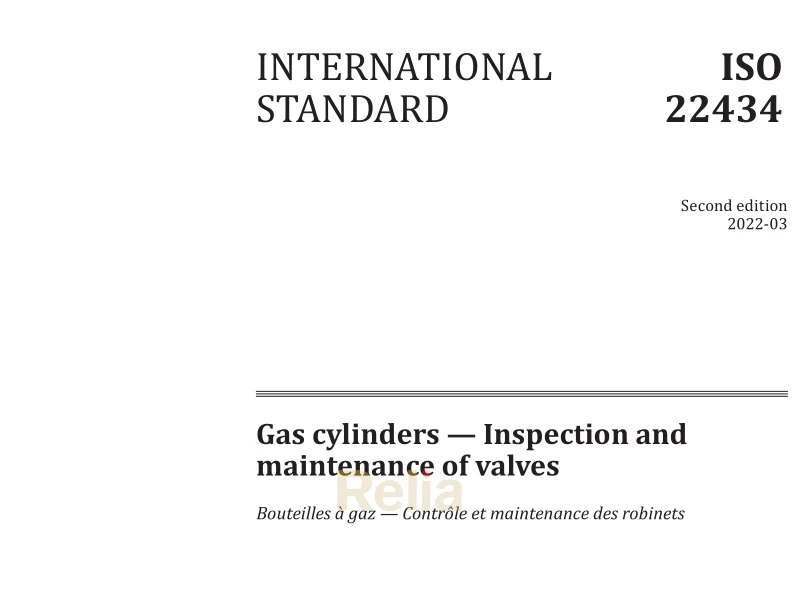BS EN lSO 15848-1: Industrial valves —Measurement,test and qualification procedures for fugitive emissions
Part 1: Classification system and qualification procedures for type testing of valves
BS EN lSO 15848 Part 1 defines type test for evaluation and qualification of valves where fugitive emissions standards are specified.
The procedures of ISO 15848 part 1 can only be used with the application of necessary precautions for testing with flammable or inert gas at temperature and under pressure.
All temperatures at location 1,2,and 3 (and 4)shall be stabilized before leakage is measured (see Figures 2 and 3).Temperature at location 3 shall be stabilized for minimum 10 min prior to leakage measurement.
Check if the temperature variation is within ±5 %.
5 Type test
5.1 Test conditions
5.1.1 Preparation of a valve to be tested
Only a fully assembled valve shall be used for the test.
A valve shall be selected from standard production at random.The valve shall have been tested and accepted in accordance with ISO 5208 or any other applicable standard and no subsequent protective coating shall have been applied.
Additional seal arrangements to allow the stem sealing system leakage measurement is permitted and shall not affect the sealing performance of the valve.
The test valve interior shall be dried and lubricants (if any)shall be removed.The valve and test equipment shall be clean and free of water,oil,and dust and the packing may be changed prior to the test.If the valve packing is changed prior to the test,it should be done under the supervision of the valve manufacturer.
If a test valve is equipped with a manually adjustable stem (or shaft)seal(s),it shall be initially adjusted according to the manufacturer's instructions and recorded in the test report as provided in Clause 7.
The valve manufacturer shall select the appropriate actuating device.
5.1.2 Test fluid
The test fluid shall be helium gas of 97 %minimum purity or methane of 97 % minimum purity.The same test fluid shall be used throughout the test.
5.1.3 Test temperature
Valve mechanical cycling is carried out at the room temperature or in the steps of the room temperature and the selected test temperature other than the room temperature (see 5.2.4.1 ).
The test temperature shall be recorded for each leakage measurement.
5.1.4 Measurement of test valv e temperature
The temperature of the test valve shall be measured at three locations,as shown in Eigure 1,and recorded in a test report.
a) Measurement at location 1 shall be used to determine the test temperature.
b) Measurement at location 2 is also made for information.Any use of insulation shall be detailed in the test report.
c) Measurement at location 3 is used to determine the external valve temperature adjacent to the stem (or shaft)seal(s)for information.
d) Measurement at location 4 is an option if measurement location 1 is not possible (except in the case where heating elements penetrate the blind flanges).
5.1.5 Leakage measurement
5.1.5.1 Stem(or shaft) leakage measurement
Leakage shall be measured from a test valve at rest in the partly open position.
The leakage measurement shall be performed
一 by the global method (vacuum or bagging)according to the procedures described in Annex A,or
一 by the local leakage measurement (sniffing)according to the procedures described in B.2.
5.1.5.2 Body seal leakage me asurement
The local leakage shall be measured by sniffing method according to the procedure described in Annex B. Evaluation of the end connections should be done to ensure that they do not affect the results of the evaluation of the body seals.
5.1.5.3 Leakage-measurement records
All results of leakage measurements shall be recorded in a test report as specified i n Clause 7.
5.2 Test procedures
5.2.1 Safety rules
Testing with high pressure gas is potentially hazardous and thus all applicable local safety rules and adequate safety measures shall be followed.If methane(CH₄)is used,the combination of the test pressure and temperature shall be reviewed for possible combustion concerns.
5.2.2 Test equipment
The test equipment shall be appropriately selected to
a)apply and maintain the test pressure within a range of±5 %of the nominal value,
b) apply valve mechanical cycles,
c)heat or cool the test valve to the selected test temperature and maintain it within a range of ±5 % but not exceeding 15 ℃;no mechanical cycling is permitted during temperature change,
d) measure and record time,pressure,temperature,leakage,and duration of a valve mechanical cycle,
e) measure and record actuation forces or torques to operate a test valve,and
f) measure and record the stem sealing system loading,if applicable.
5.2.3 Stem (or shaft)seal adjustment (SSA)
5.2.3.1 Number of s tem seal adjustment
Mechanical adjustments of stem (or shaft)sealing system during the type test shall be permitted only once,as shown below,for each of qualification stage done according to Figures 4,5 ,and 6 ,if stem (or shaft)leakage has been measured in excess of the target tightness class selected from Ta bles 1to 4.
The maximum retightening force (or torque)to apply shall be determined prior to the type test.
EXAMPLE
一 A maximum of one adjustment is accepted for CC1 or CO1
一 A maximum of two adjustments is accepted for CC2 or CO2.
一 A maximum of three adjustments is accepted for CC3 or CO3.
5.2.3.2 Test failure after stem seal adjustment
If a stem(or shaft)sealing arrangement fails to achieve the target tightness class,or it is not possible to continue mechanical cycling,the test shall be considered terminated,and the test valve shall be evaluated for qualification of lower tightness and endurance classes,if applicable.
5.2.3.3 Reporting the number o f SSA
The total number of stem (or shaft)seal adjustment shall be recorded in the test report and indicated in the designation of the valve classification as “SSA-1”,"SSA-2”,and “SSA-3".
5.2.4 Test description
5.2.4.1 General
The test description is the following:
a) The test valve shall be mounted on atestrig,according to the instructions given by the manufacturer.
b) The valve mounting shall be principally made with a stem (or shaft)positioned vertical.A valve intended for use in other positions shall be mounted with the stem (or shaft)positioned horizontally.
c) All sealing systems shall have been properly adjusted beforehand,according to the manufacturer's instructions.For valves using packings as a stem seal,the tightening torque of the gland boltings shall be measured and recorded at the beginning of the test and after any stem seal adjustment.
d) The target number and combination of mechanical and thermal cycles shall be selected from the endurance classes specified in Figures 4,5,and 6 .
e) Leakage from the stem (or shaft)seal and from the body seals shall be separately measured.If the valve does not allow such a separate measurement,the total leakage of both stem (or shaft)and body seals shall be measured at the same time according to Annex A and Ann ex B respectively.
f) Actual methods of mechanical cycles other than those specified in 5.2.4.2 and 5.2.4.3 shall be in accordance with the manufacturer's instructions,and opening,closing,and dwelling time shall be recorded in the test report.Basically,they shall represent the intended operating conditions of a test valve.
g) Valve opening and closing force (or torque)shall be measured and recorded at the start and at the end of the test,following subsequent stem seal adjustments if applicable.
5.2.4.2 Mechanical cycles of isolating valves
Unless otherwise specified by the valve manufacturer,the valve seating force (or torque)required for tightness under a differential pressure of 0,6 MPa (6 bar),air or inert gas shall be used as the minimum force [or torque]for mechanical cycle of a test valve.
Fully back seating a test valve is not required.
5.2.4.3 Mechanical cycles of control valves
The stem motion of linear action valves shall be between 1 mm/s and 5 mm/s.The shaft motion of rotary control valves shall be between 1/s and 5°/s.
The actuator to operate a test valve shall withstand only the pressure and friction force (or torque) acting on the valve stem,and these values shall be recorded.
NOTE Measurement of friction force (or torque)is principally intended to check the packing friction usually expressed as the dead band.
5.2.4.4 Preliminary tests at the room temperature (test 1)
The tests are carried out as shown below.
a) Pressurize a test valve with the test fluid to the test pressure as specified in a relevant standard.
b) After the test pressure has been stabilized,measure leakages both from the stem (or shaft)seal and from the body seals,in accordance with Annexes A and B,respectively.
c) Record the test result in a test report.
5.2.4.5 Mechanical cycle test at the room temperature (test 2)
The tests are carried out as shown below.
a) Perform mechanical cycles at room temperature while the test valve is kept pressurized.
b) Measure the leakage from the stem (or shaft)seal only,in accordance with Annex A.
c) Record the test result in the test report.
d) Repeat the test in case of Class CO1 and CC1,as indicated i n Figures 4 and 6 .
5.2.4.6 Static test at the selected test temperature (test 3)
The tests are carried out as shown below.
a) Pressurize a test valve with the test fluid to the test pressure as specified in a relevant standard for the selected test temperature selected from Table 5.
b)After the test pressure has been stabilized,adjust the valve temperature to the selected test temperature,ensuring that the test pressure does not exceed the level specified in the relevant standard.
c) After the valve temperature has been stabilized with an allowance of ±5 % with a maximum of 15℃,measure the leakage from the stem (or shaft)seal only in accordance with Annex A.
d) Record the test result in the test report.
e) Repeat the test in case of Class CO1 and CC1,as indicated in Figures 4 and 6.
5.2.4.7 Mechanical cycle test at t he selected test temperature (test 4)
The tests are carried out as shown below.
a) Perform mechanical cycles at the selected test temperature while the test valve is kept pressurized.
b) Measure the leakage from the stem (or shaft)seal only in accordance with Annex A.
c) Record the test result in a test report.
d) Repeat the test in case of Class CO1 and CC1,as indicated in Figures 4 and 6.
5.2.4.8 Intermediate static test at th e room temperature (test 5)
The tests are carried out as shown below.
a) Allow a test valve to return to the room temperature,without artificial cooling (or heating).
b) After the valve temperature has been stabilized,measure the leakage from the stem (or shaft)seal only in accordance with Annex A.
c) Record the test result in a test report.
5.2.4.9 Final test at the room temperature (test 6)
The tests are carried out as shown below.
a) Allow a test valve to return to the room temperature,without artificial measures.
b) After the valve temperature has been stabilized,measure the leakage from the stem (or shaft)seal in accordance with Annex A and from body seals in accordance with Annex B.
c) Record the test results in the test report.
5.2.4.10 Post-test examination
After all the tests have been successfully completed,the test valve shall be disassembled and all sealing components shall be visually examined to record notable wear and any other significant observations for information.
5.2.4.11 Qualification
Tested valves shall be qualified when
一 all steps of test procedures have been satisfactorily performed for the target performance class,and
一 all leakage measurements are verified equal or lower than the values specified for the target performance class
